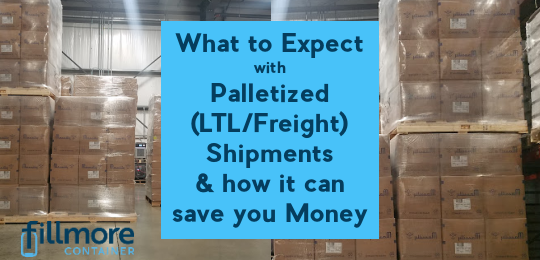
What to expect with Palletized Shipping & how it can save you money
Palletized Shipping can save you money on shipping costs and often on products as well. It’s important to know if palletized shipping is a viable option for you. In this post, we explain what LTL shipment or a Palletized Shipment is, what to expect with palletized shipping and how it saves you money. We will also explain how to choose this shipping method, the accessorials that you may need, and their associated costs. Many of our customers save money on shipping but are also able to see the savings of other pricing tiers as the y transition to palletized (LTL/Freight) shipments.
*If you are considering this method of shipping, it is crucial to read the entirety of this post to ensure a smooth delivery process.*
Palletized Shipping – FAQ
What is palletized (or LTL) shipping?
The order is stacked onto a pallet(s), double-checked, carefully and securely wrapped, and weighed. A Bill of Lading (BOL) is created for the carrier. The BOL includes weight and the details required for delivery. It is delivered on a delivery truck. ETA’s for these are based on the best information provided to us. (If you are designated as Rural, the ETA will not likely be met, as Rural designations are not on a daily delivery route.)
Do I need to purchase a whole pallet of one item?
No, you do not! When our shipping quotation tool offers LTL as an option, it means that the cost of LTL is comparable to receiving it in cartons delivered by a UPS Ground (package). You can see in this image below, how small an LTL order could be. This was an actual recent order.
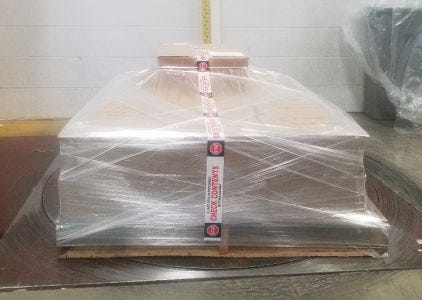
Full pallets can be very tall, so if there are any height or total weight restrictions, we must be aware of them. Because carriers have some height or life-gate restrictions, there are some products that ship on 2 pallets when purchasing “full pallet” quantities. Freight costs are generally based on total weight rather than pallet positions.
How do I save more money?
You can save more money by seeing how many more items (cases) you can add to your pallet before the shipping price increases. Ground package orders increase in cost in response to very small changes in weight. Since palletized shipping costs increase in response to larger weight amounts, you can often see savings beyond the quantities in your initial order (as shown below).
“I was frustrated with shipping costs until I saw your recommendation on how to reduce costs. Then I was finally sold on purchasing from you. It was a great idea and I really appreciated it.”
Keith B.
Example 1
This shipping example illustrates the costs of shipping 60 cases of 4oz. Tapered Mason Jars via multiple shipment options. UPS Ground is often the common choice, but if you look at UPS freight/pallet you can see there is a savings by choosing freight.
*Estimated shipping costs before any accessory charge. Actual unit price and shipping rates are displayed as examples only.
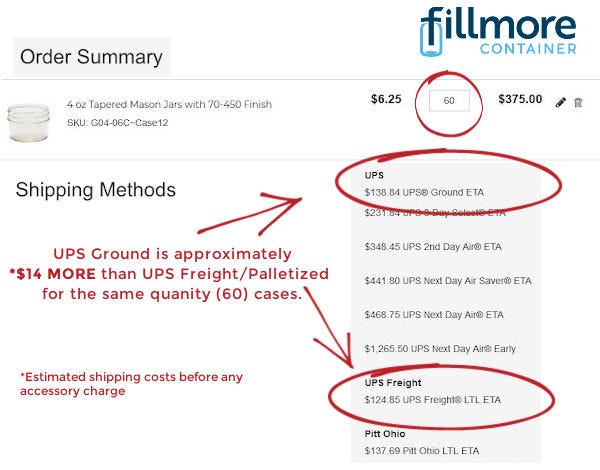
Calculated delivered cost per case UPS Ground- $8.57
Calculated delivered cost per case UPS Freight – $8.34
Example 2
This shipping example illustrates the costs of increasing the number of cases purchased from 60 to 90 cases of 4oz. Tapered Mason Jars. UPS Ground is often the common choice, but if you look at UPS freight/pallet you can see there is a more than $80 savings by choosing freight. In addition to the savings, you’ll get more product – saving you additional shipping costs that would’ve been accrued via more frequent orders and shipping costs associated with each order.
*Estimated shipping costs before any accessory charge. Actual unit price and shipping rates are displayed as examples only.
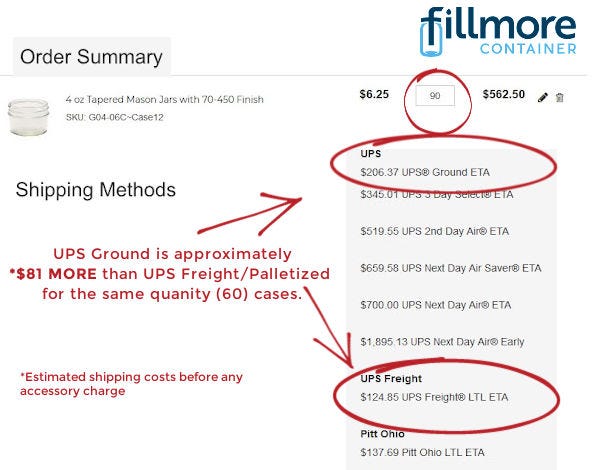
Calculated delivered cost per case UPS Ground- $8.55
Calculated delivered cost per case UPS Freight – $7.64
How do I save money on my product?
You can save even more money as you reach the next price tiers. Be sure to take a look at them as you are planning your order. If you have the space, and the capital, you may wish to consider larger orders less frequently. Pay special attention to your lids because there is significant savings in ordering the full case. We don’t recommend over-ordering lids, since the plastisol can age, but a safe rule of thumb would be to use them in a year after your purchase. Some basic planning can result in significant savings in the long run.
What are Accessorials?
Choosing a freight/LTL shipment is different than having UPS Ground deliver your boxes. Accessorials are items that include (but are not limited to) lift-gate, residential delivery, inside delivery, scheduling an appointment, etc. Some of these items have fees attached, some do not, but identifying the needed accessorials for your delivery is crucial. These accessorials must be accurately identified by you at the time of your order. We explain a few of them below. If this is the first time placing a palletized order, and you want to make sure you’re doing it properly, feel free to give our customer service team a call when you get to this point in checkout. Our ETA is based on straight commercial delivery with no need for accessorials. Time in transit will be impacted by the addition of accessorials. For example, not every terminal has equal access to trucks with lift-gates, and there may a delay. Below is what you would see as you check out.
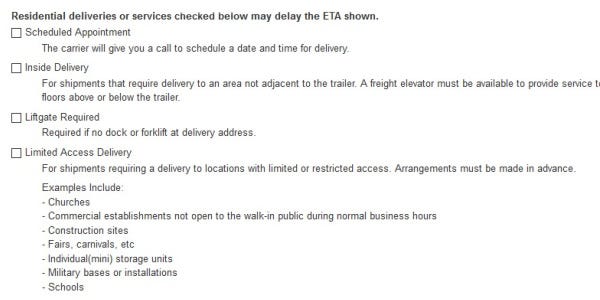
- Scheduled Appointment: Residential automatically must schedule a delivery appointment. (See more details below.)
- Inside Delivery: This is only honored for commercial deliveries. (See more details below.)
- Lift-Gate: This must be chosen if you do not have a dock for a tractor-trailer or a forklift that will safely lift & lower the intact pallet from the trailer.
- Limited Access Delivery: Arrangements must be made in advance for deliveries to locations that have limited or restricted access. While it includes those on the list in the image above, it can also apply to narrow road access, height restricted access (trees, electrical lines, structural items) cornering ability restrictions, bridge weight restrictions etc. This can also apply to seasonal road conditions.
What to expect with Residential Delivery?
You must be present for delivery. (LTL orders will not be left without a signature.) Inside Delivery may not be selected for/can not be honored for residential deliveries. If this is a residential delivery or you have requested a scheduled appointment, the dispatcher or driver will call to arrange a window of time and delivery day. It is very important that the phone number provided is the best one to successfully reach you. If you are not there, and a second delivery attempt must be arranged, there will be an additional fee. This is curbside delivery – which means that they do not drive onto your property, but place the pallet(s) curbside. Drivers are not expected to roll your pallet up your driveway, or into your garage or storage unit. Even if some drivers may have done this in the past, it is not their responsibility, and may in fact be a liability. It is not to be expected. Be prepared for delivery with a printout of your order and phone/camera to document any damage. (There usually isn’t, but proper proof is needed for the problem to be resolved.)
Please note: Commercial or Residential delivery status is a zoned location and is designated by the carrier. This is not related to whether you are commercially licensed to produce a product, or have a permit to run a business out of your home, or even a separate building that is on your residential property. If you are unsure about the delivery designation, please check with our customer service. Any fees associated with an inaccurate designation by the customer, including re-delivery attempts, etc are the responsibility of the customer.
What to expect with Commercial Delivery?
You must be present for delivery. (LTL orders will not be left without a signature.) When delivery can not be received between the hours of 8 – 5, Monday – Friday, you should choose “schedule and appointment”. In choosing to schedule an appointment, it is very important that the phone number provided is the best one to successfully reach you. If you are not there, and a second delivery attempt must be arranged, there will be an additional fee.
If requesting an Inside Delivery, it is your responsibility to make us aware of any height or width restrictions. An average pallet is about 45″ x 50″ and can be 96″ tall. Consider clearance required for necessary pallet jack or equipment used to move the pallet(s). This requires absence of obstacles – steps, thresholds, uneven flooring. A delivery driver is not responsible for unstacking a pallet, but rather to get the pallet(s) to, or as close to the desired location as allowed by physical limits of the building.
Please note: Commercial or Residential delivery status is a zoned location and is designated by the carrier. This is not related to whether you are commercially licensed to produce a product, or have a permit to run a business out of your home, or even a separate building that is on your residential property. If you are unsure about the delivery designation, please check with our customer service. Any fees associated with an inaccurate designation by the customer, including re-delivery attempts, etc are the responsibility of the customer.
What to do before signing the paperwork
Before you sign any paperwork, be sure to carefully inspect the pallet(s) properly for accuracy and/or damage as described below. Understandably, drivers are usually in a hurry and can come off as pushy. You are entitled to a reasonable time to inspect your delivery.
- Accuracy: Although a Packing Slip is affixed to the wrapped pallet for easy reference, having the printout of your order with you is helpful to verify your order is complete. We wrap these pallets carefully and place warning tape across the top as a tamper-evident indicator. If it appears like it was re-wrapped, be extra careful to make sure that all items are present. Take a picture of the pallet in question before you sign and before the driver leaves. If there is any shortage, make note of it on the delivery receipt as you sign it. Take a picture of the signed document and email it to us. Signing without indication of missing items leaves us no recourse with the carrier. (We have footage of all shipments after they are wrapped, taped, and ready to be shipped)
- Damage: Carefully inspect the pallet, and the wrapping and make note of any visible damage on the delivery receipt before signing. If you notice minimal damage, take a picture and make sure damage is noted on the paperwork before signing. We wrap these pallets carefully and place warning tape across the top as a tamper-evident indicator. It is a more efficient claims process and replacement process if all damage is claimed on the paperwork. To the best of your ability, approximate the number of cases involved and the extent of the damage. We recognize additional damage may be found when the carrier is gone, and those details should be provided to us ASAP. If paperwork is signed without notification of damage, we have no recourse with the carrier. If the damage is very bad, we would recommend giving us a call. Simply refusing a delivery (even if it was damaged in transit) takes much longer to rectify, and is not recommended.
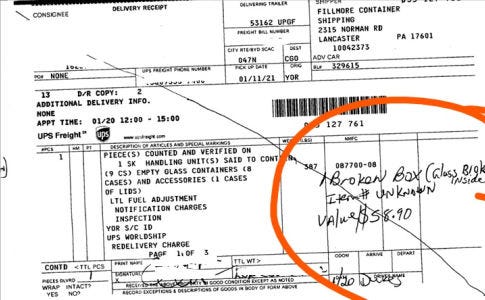

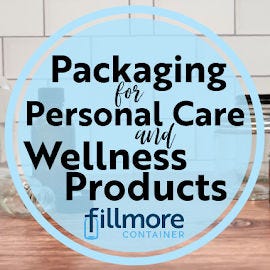

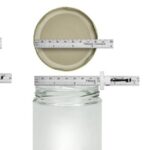

Very helpful information. I have been thinking about doing this but was never sure if I could because I don’t have a dock or forklift.
We are located in TRINIDAD ,West Indies and have to pay approximately 40 % Ocean Freight on cargo
we have to pay between 15-20% customs duty plus 12.5% VAT these cost are base on cost & freight of
goods,so we are at a great disadvantage,when we also have to pay inland shipping cost.
Yes, unfortunately, shipping is a painful part of the cost – especially right now. Because international shipping is so high, it really only becomes affordable if you can coordinate with other businesses to help share the cost of brokering the shipment.